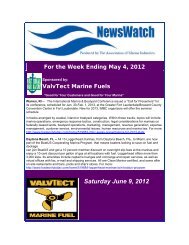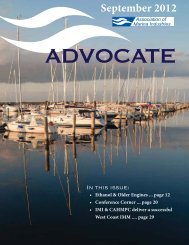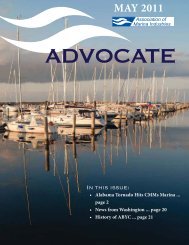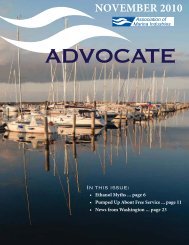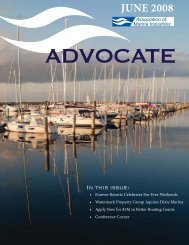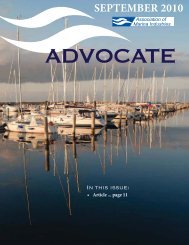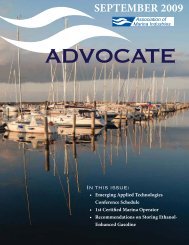Entire Document - California Department of Boating and Waterways ...
Entire Document - California Department of Boating and Waterways ...
Entire Document - California Department of Boating and Waterways ...
Create successful ePaper yourself
Turn your PDF publications into a flip-book with our unique Google optimized e-Paper software.
season, nor is it too liberal to meet occasional circumstances that precipitate highpedestrian traffic during holiday weekends, or emergencies such as a marina orboat fire, oil spill, earthquake or flood event.......................................................................C2.2.1.1 Uniform Live Load - Application ProblemsCommentary:For example, in highly exposed locations where floating docks are periodicallysubjected to rough water, the use <strong>of</strong> thin-deck glue-laminated floating wood docksmay be the only practical design choice. Such dock systems consist <strong>of</strong> a structuraldeck typically ranging from 3 to 6 inches in thickness to which flotation pontoons arefastened. Done properly, such a float system is flexible, has a low dead weight, <strong>and</strong>functions well in rough water compared to heavier dock systems.However, in order to meet a 25#/ft 2 ULL, the attachment <strong>of</strong> the number <strong>and</strong> spacing<strong>of</strong> flotation pontoons necessary to comply with the loading <strong>and</strong> freeboardrequirements effectively stiffens the thin wood deck <strong>and</strong> diminishes its ability to flexproperly in rough water. The more pontoons, <strong>and</strong> the larger the dimensions <strong>of</strong> thepontoons, the stiffer the dock.Illustration: A section <strong>of</strong> dock 8 ft x 50 ft has a deck area <strong>of</strong> 400 ft 2 . A25#/ft 2 ULL applied to the deck area results in a total ULL load <strong>of</strong> 10,000#.Assuming that the entire dock DL plus any applied live point load is about4,000#, the total DL + ULL <strong>of</strong> the dock section is about 14,000#. One 12" x 12"x 12" cube (1 cubic ft) <strong>of</strong> totally submerged flotation material will support about60#, or 5# per inch <strong>of</strong> submergence. Thus, 14,000# ÷ 60#/ft 3 indicates the needfor about 235 ft 3 <strong>of</strong> flotation. The size <strong>and</strong> number <strong>of</strong> pontoons can now bedetermined with consideration to pontoon weight, depth <strong>and</strong> dimensions. Usingdeeper pontoons, with smaller length <strong>and</strong> width dimensions, will reduce thenumber <strong>and</strong> size <strong>of</strong> the pontoons, allowing for greater flexibility. Using shallowerpontoons, with larger length <strong>and</strong> width dimensions, will require a greaternumber <strong>of</strong> larger pontoons <strong>and</strong> will stiffen the dock. These are the trade<strong>of</strong>fs thatthe designer faces when using a thin deck flexible dock system.In such situations, dock designers may be tempted to compromise the 25#/ft 2 ULLrequirement in order to provide the desirable flexibility in a dock for a specific site. Inpast years, a ULL <strong>of</strong> 12#/ft 2 has sometimes been used to address this problem.However, this is not a recommended option. The 25#/ft 2 ULL has beenestablished to address not only the performance <strong>of</strong> the dock system, but the needs<strong>and</strong> safety <strong>of</strong> the boaters who use the docks as well. During rough water periods,there may be little or no pedestrian traffic on the dock during a storm. When 3 to 4foot high waves are rolling through such a dock system, it may be very difficult toeven walk on the dock, depending <strong>of</strong> the frequency <strong>and</strong> height <strong>of</strong> the waves.However, under less severe conditions, the 25#/ft 2 ULL is necessary in the design<strong>of</strong> the docks in order to provide for public safety, protection <strong>of</strong> utilities <strong>and</strong> servicesbuilt into the dock, necessary freeboard heights, <strong>and</strong> a reasonable factor <strong>of</strong> safetyduring periods <strong>of</strong> high pedestrian traffic as described above.Appendix A -- Section C Commentary - Page 71



